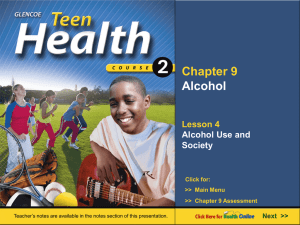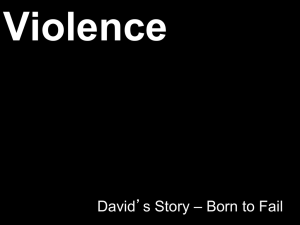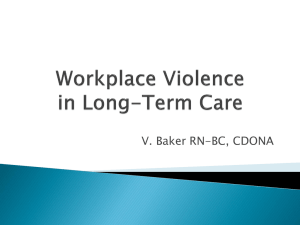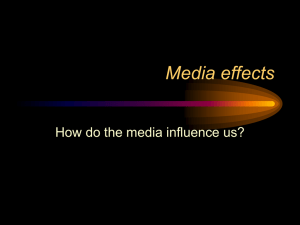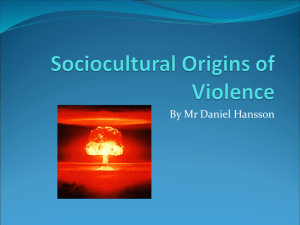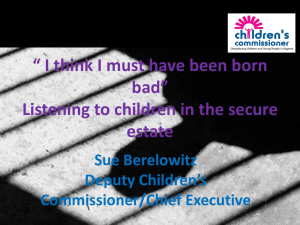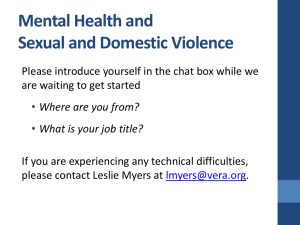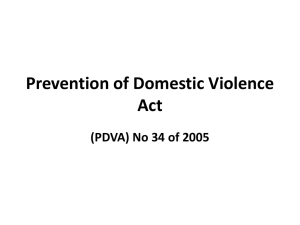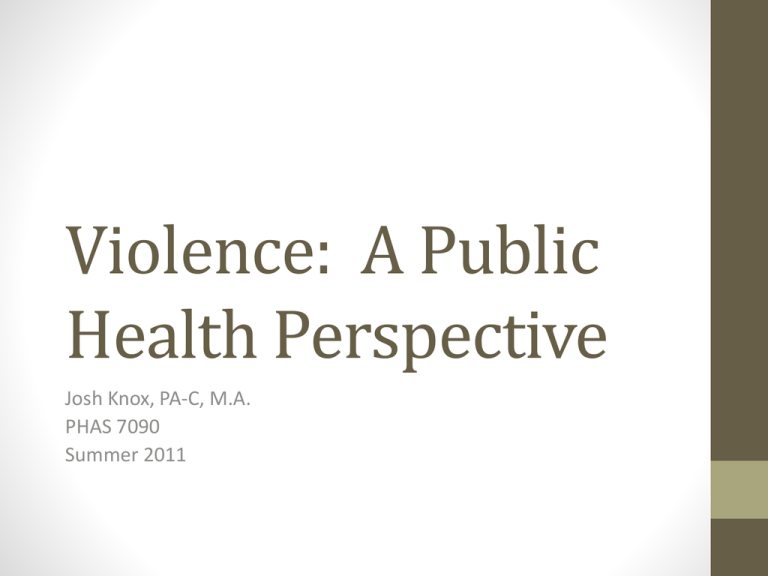
Violence: A Public
Health Perspective
Josh Knox, PA-C, M.A.
PHAS 7090
Summer 2011
Educational Objectives
• Discuss the root causes of violence and its
effects on self, women, children, youth,
elders & society from a health perspective.
• Recognize that violence is preventable &
the role of the PA in that prevention.
• Discuss prevention strategies for selfdirected, child, intimate partner, and
youth violence.
Violence Defined
• World report on violence and health (WRVH): "the intentional
use of physical force or power, threatened or actual, against
oneself, another person, or against a group or community,
that either results in or has a high likelihood of resulting in
injury, death, psychological harm, mal-development, or
deprivation."
Types of Violence
• Intrapersonal Violence: Suicide
• Interpersonal Violence
• Child Maltreatment
• Youth Violence
• Intimate Partner Violence
• Elder abuse
• Sexual Violence
• Collective Violence: War/Uprisings
Impact of Violence on Society
• > 50, 000 per year die d/t violence in U.S. (2005)1
• 2. 5 million injuries due to interpersonal & selfdirected violence2.
• The total costs associated with nonfatal injuries
and deaths due to violence was more than $70
billion (2000).
• $64.4 billion or 92% due to lost productivity.
• $5.6 billion was spent on medical care
Why should a PA bother?
• There is strong evidence that violence can be prevented
and its impact reduced similar to what has been done
for:
• Traumatic injuries
• Infectious diseases
• Pregnancy complications
What Causes Violence?
• Bad
neighborhoods/housing
or
unemployment/deadend jobs.
• Bad genes or bad
morals.
In reality it looks like…..
Biologic Causes of Violence
• “No patterns precise enough to be considered
reliable biological markers for violent behavior
have yet been identified”-NAS1
Sociologic Factors in Violence
• Drastic differences in violence rates.
• In general, smaller communities have lower rates of violence.
• Within the same city, some neighborhoods have rates of violent
crime 300 times higher than other neighborhoods.
• People who commit violence (on the street) are
disproportionately poor and unemployed.
• The overwhelming majority of people arrested for crimes of
violence are men.
• Violence is primarily the work of the young.
• People in their late teens and twenties are much more likely to be
arrested for violence than younger or older people.
• The arrest rate--and the victimization rate--for violent crime
for African-Americans is six times higher than for whites.
Neighborhoods & Violence
• Collective Efficacy- social cohesion among neighbors combined
with their willingness to intervene on behalf of the common
good.
• Collective efficacy is negatively associated with violence
Psychological Factors
• Mental illness plays a small role in interpersonal violence1.
• Effects of family are the most powerful influence across most
forms of violence.
Suicidal Violent Behavior &
Consequences
• Suicidal behavior exists along a continuum1:
•
•
•
•
Thinking about ending one's life "suicidal ideation“
Developing a plan
Non-fatal suicidal behavior "suicide attempt“
Ending one's life "suicide“
• 33,000 suicides each year (CDC, 2010).
• 392,000 people with self-inflicted injuries sought treatment in
emergency departments (CDC, 2010).
• It is estimated that for every one suicide there are 25
attempts1.
Suicide was the 11th leading cause of death among persons ages 10 years and
.
older, accounting for 33,289 deaths in 2006
Suicide Risk Factors
• Risk Factors:
•
•
•
•
•
•
•
•
•
•
•
•
•
Family history of suicide
Family history of child maltreatment
Previous suicide attempt(s)
History of mental disorders, particularly clinical depression
History of alcohol and substance abuse
Feelings of hopelessness
Impulsive or aggressive tendencies
Cultural and religious beliefs
Local epidemics of suicide
Isolation, a feeling of being cut off from other people
Loss (relational, social, work, or financial)
Physical illness
Easy access to lethal methods
Suicide Protective Factors
• Protective Factors
• Effective clinical care for mental, physical, and substance abuse
disorders
• Easy access to a variety of clinical interventions and support for
help seeking
• Family and community support (connectedness)
• Support from ongoing medical and mental health care
relationships
• Skills in problem solving, conflict resolution, and nonviolent ways
of handling disputes
• Cultural and religious beliefs that discourage suicide and support
instincts for self-preservation
Guns and Suicide
• Guns in the home are the primary source for
firearms that teenagers use to kill themselves in
the United States1.
Suicide Prevention: The
Evidence
• Treatment of Mental Health Disorders
• Treatment of Substance Abuse
• Behavioral Therapy
• Restrictive firearm licensing and purchase
policies?
• Increasing Social Connectedness?
• Suicide Prevention Centers?
Child Maltreatment
• Child maltreatment: all types of abuse and
neglect of a child under 18 by a parent,
caregiver, or another person in a custodial role .
• There are four common types of abuse:
• Physical Abuse
• Sexual Abuse
• Emotional Abuse
• Neglect
Child maltreatment prevalence
& consequences
• 763,000 children victims of maltreatment in 2009 1
• 8,755,000 children were victims of child maltreatment during a oneyear time frame2. (essentially 1/7 U.S. children)
• 1,770 children across the country died from abuse 1. (2008)
• Long-term consequences on cognitive, language, and socioemotional development, and mental health.
• Severe or fatal head trauma. Nonfatal consequences of abusive head
trauma include visual impairment, motor impairment & cognitive
impairments.3
• Increased risk for adverse health effects &chronic diseases4.
• Increased risk of addictive disorders, mental health conditions, low
academic achievement & relationship dysfunction.
Child maltreatment risk factors
• Individual Risk Factors
• Children < 4
• Special needs child
• Risk Factors for Perpetration
• Parents' lack of understanding of
children's needs, child
development & parenting skills
• Parental history of maltreatment
• Substance abuse and/or mental
health issues including depression
• Parental characteristics such as
young age, low education, single
parenthood, large number of
children, &d low income
• Non-biological caregivers in the
home
• Family Risk Factors
• Social isolation
• Family disorganization,
dissolution, & violence.
• Parenting stress, poor parentchild relationships, and
negative interactions
• Community Risk Factors
• Violence
• Concentrated neighborhood
disadvantage & poor social
connections.
Evidenced Based Interventions with Impact on
Child Maltreatment
• Child-Parent Centers
• Nurse family Partnerships
• Positive Parenting Program
Youth Violence Definition &
Consequences
• Youth violence: the intentional use of physical force or power,
threatened or actual, against another person or against a
group or community that results in or has a high likelihood of
resulting in injury, death, psychological harm, maldevelopment, or deprivation typically including persons
between the ages of 10 and 24.
• 700,000 youth ages 10 to 24 are treated in ER’s/yr for injuries
sustained due to violence-related assaults.
• 16 persons b/t 10 and 24 are murdered each day in the U.S.
• YV increases the cost of health care, reduces productivity,
decreases property values, and disrupts social services
Youth Violence Risk Factors
•
•
•
•
Individual Risk Factors
• Attention deficits, hyperactivity or learning disorders
• History of early aggressive behavior
• Involvement with drugs, alcohol or tobacco
• Low IQ or deficits in social cognitive or information-processing abilities
• Antisocial beliefs and attitudes
• Exposure to violence and conflict in the family
Family Risk Factors
• Harsh, lax or inconsistent disciplinary practices
• Low parental involvement
• Low emotional attachment to parents or caregivers
• Low parental education and income
• Parental substance abuse or criminality
• Poor family functioning
Peer/Social Risk Factors
• Association with delinquent peers/Involvement in gangs
• Lack of involvement in conventional activities
• Poor academic performance
• Low commitment to school and school failure
Community Risk Factors
• High concentrations of poor residents
• High level of transiency
• High level of family disruption
• Low levels of community participation
• Socially disorganized neighborhoods
Youth Violence Protective
Factors
• Individual/Family Protective Factors
•
•
•
•
•
High IQ/GPA
Positive social orientation
Religiosity
Connectedness to family or adults outside the family
Consistent presence of parent during at least one of the
following: when awakening, when arriving home from school, at
evening mealtime or going to bed
• Involvement in social activities
• Peer/Social Protective Factors
• Commitment to school
• Involvement in social activities
Youth Violence Prevention:
The Evidence
• Parent training
• Skills training
• Social development programs
• Big Brothers/Big Sisters
• Urban Ecology Center
• Regulating access to alcohol
• Restrictive firearm licensing & purchase
• Enforced bans on public firearms
Intimate Partner Violence
• Intimate partner violence: physical, sexual, or psychological
harm by a current or former partner or spouse. This type of
violence can occur among heterosexual or same-sex couples
and does not require sexual intimacy*.
• Costs of intimate partner violence (IPV) against women in
1995 exceeded $5.8 billion.
• Victims of severe IPV lose nearly 8 million days of paid workthe equivalent of more than 32,000 full-time jobs-and almost
5.6 million days of household productivity/yr.
• 329 males and 1181 females were murdered by an intimate
partner (Bureau of Justice Statistics 2007)
Intimate Partner ViolenceRisk
Factors
•
Individual Risk Factors
• Low income/unemployment
• Low academic achievement
• Young age
• Heavy alcohol and drug use
• Mental health condition
• Belief in strict gender roles (e.g., male dominance and aggression in relationships)
• Being a victim of physical or psychological abuse (consistently one of the strongest predictors of perpetration)
• History of experiencing poor parenting as a child
• History of experiencing physical discipline as a child
•
Relationship Factors
• Marital conflict-fights, tension, and other struggles
• Marital instability-divorces or separations
Community Factors
• Poverty and associated factors (e.g., overcrowding)
• Low social capital-lack of institutions, relationships, and norms that shape a community's social interactions
Societal Factors
• Traditional gender norms (e.g., women should stay at home, not enter workforce, and be submissive; men
support the family and make the decisions)
•
•
Intimate Partner Violence:
Prevention Interventions
• Interventions for problem drinking
partners
• School based programs addressing gender
norms
• Screening and referral
• Advocacy support programs
• Protection orders
A final word on firearm
violence
• A gun in the home is 22 times more likely
to be used in an unintentional shooting,
than to be used to injure or kill in selfdefense1.
• http://changegunviolence.com/
• What ways could diverse communities benefit from the examples
of engagement in Monday’s film?
• What situations could you potentially encounter as PA’s in
Monday’s film?


